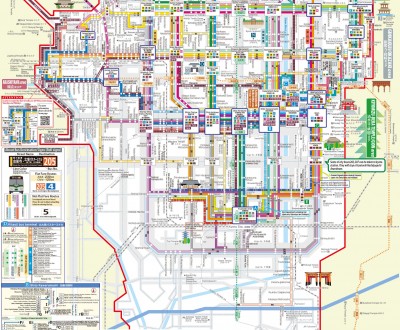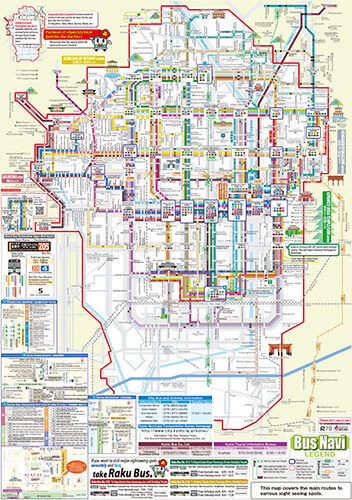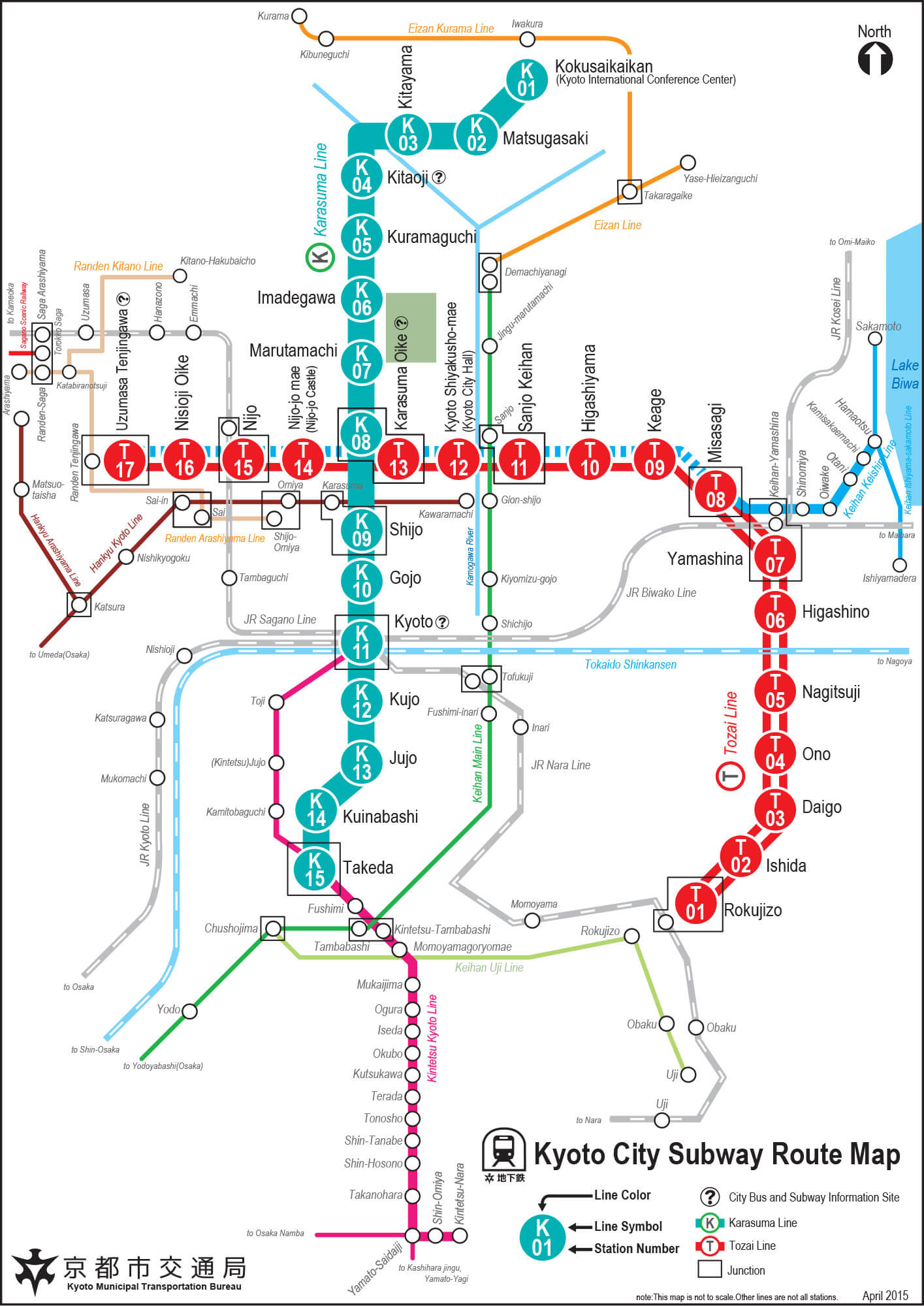A Guide to Riding the Kyoto Buses
🚌 Buses and 🚇 Subway
Kyoto’s transportation network is much criticized as it does not actually offer comprehensive and comfortable travel solutions:
- The subway covers a limited number of destinations, as its network consists of only two lines;
- The train is mainly intended to leave the city center, and move either westward to Sagano, northward to Kurama or southward to Inari;
- Bicycle is convenient in and around Kyoto’s center. However, its use is rather uncomfortable outside those limits despite recent efforts towards creating more cycling infrastructures;
- Taxi are a convenient solution for a number of routes, but are obviously the most expensive one, and affordable only to a few travelers.
Therefore, and despite the drawbacks of this solution, buses have become the most widely used transportation for visiting the former capital of Japan (and for its elderly inhabitants whose numbers reflect the population decline). Since it is not that easy to find one’s way around with buses, we have devised a guide for traveling smoothly.
🚌 Kyoto buses: network maps, pros and cons
Click on the picture to display it full size.
Kyoto buses have some advantages:
- Since buses use the well-developed Kyoto street and road network, they can cover most tourist destinations;
- They run quite frequently on the most used lines;
- The number of announcements in English, especially for tourist attractions, in increasing;
- "Special" buses, numbers 202 and 205, are loop lines and numbers 100, 101 and 102 serve the most visited places;
- Municipal buses are compatible with IC cards (contactless, like the Suica card) since 2014.
On the down side:
- One-way tickets are expensive and there is no discount for IC card holders;
- It is impossible to use the Japan Rail Pass in Kyoto buses;
- Most lines have limited schedules and service sometimes ends before 5 p. m.;
- Traffic congestion is increasing in Kyoto, causing buses to run late quite often;
- Information displays only deliver basic, undetailed information, that is not always translated;
- Buses tend to be overcrowded, especially on the main lines and/or during rush hours;
- In most cases, carrying any luggage around will prove impossible;
- As often on Japanese buses, the seat size does not fit people of taller or bigger build.
Fares and Bus passes
Kyoto Municipal buses are painted green. There are two different types which are described in detail below.
Buses serving the city only
They only serve downtown Kyoto; Arashiyama for example is not included and a different rate will apply to get there. Each line number is painted a different color. A single rate applies for all tickets regardless the number of stops or the distance covered:
- Adults: ¥230 (~US$1.50)
- Children from 6 to 12: ¥120 (~US$0.78)
The City Bus All-Day Pass is available to travel an unlimited number of trips per day. It can be bought in all buses or from automatic ticket vending machines at several stops:
- Adults: ¥700 (~US$4.57) since October 2021
- Children: ¥350 (~US$2.28)
The All-Day Pass pays off from the 4th trip on the same day. Be aware, however, that it cannot be used over a 24-hour time span. It is only valid for a day, i.e. from morning through evening. Even if you start using it in the afternoon, it will not be valid any more the next morning.
In February 2023, the scrapping of the "Bus 1-Day Pass" is announced, coming into effect on 2024, April 1rst. It is still purchasable until September 2023 for a use before 2024, March 31. Kyoto city is indeed trying to encourage sightseers to take the subway 🚇 in order to ease bus congestion. The more expensive bus + subway combined pass remains available (see fares at the end of the article).
In 2000, the pass prize was lowered from ¥700 to ¥500, which spurred the sales to one million the same year, and up to 6,14 million in 2015. In March 2018, Then, over a period of a few years, the One-Day Pass’s price rose 🌹 again to ¥600 (~US$3.91), then to ¥700 (~US$4.57) in an attempt to limit its use by tourists.
In June 2023, Kyoto’s municipal government announced seriously considering a specific fare for Kyoto residents, implying an additional charge for Japanese and international tourists. However, this policy must be legally approved by the Japanese Ministry of Land, Infrastructure, Transport and Tourism before its implementation.
Buses serving the city and the suburbs
Their distinctive feature is the line number painted on a white background. The fare is calculated according to the number of stops.
They offer another type of pass called "Kyoto Sightseeing" (half-price for children):
- 1 day: ¥1,200 (~US$7.83)
- 2 days: ¥2,000 (~US$13.05)
When you purchase this pass, you get a free map plus a range of discounts in some Kyoto stores.
Planning an itinerary
The good news for people who like to plan ahead or worry about how to find their way: there is a local version of Hyperdia, called Arukumachi, dedicated to Kyoto's transportation network.
On Arukumachi’s website, you will find information about itineraries, schedules and fares and a downloadable app for smartphone 📱 is available.
How to use the bus in Kyoto
As everywhere in Japan, people wait in line at the bus stop and carefully make sure not to block the sidewalk. Passengers board through the rear door. The procedure may then vary depending on the bus type.
Buses serving the city only:
- You do not have to buy a ticket upon boarding.
- Before your chosen stop, press one of the stop buttons to request the bus driver to stop.
- Pay your ticket when getting off the bus, in the machine next to the driver. You can use either:
- Cash;
- IC card;
- Or Purchase or show a pass.
Buses serving the city and the suburbs:
- Upon boarding, you may:
- Take a numbered ticket;
- Use your IC card;
- Punch your pass if you already have one; Or,
- Just wait to buy your pass when you get off.
- Before your chosen stop, press one of the stop buttons to request the driver to stop.
- You pay the exact amount for your trip (displayed at the front of the bus and matching your ticket number) to the machine next to the driver before you get off:
- In cash;
- With your IC card;
- By showing your pass;
- By purchasing a pass.
Just like in most buses around the world, the name of the next stop is displayed on a screen in the front part of the vehicle, often spelled out in Japanese and sometimes translated into English.
The machine by the driver’s seat
Located on the left of the driver (who sits on the right-hand front of the vehicle), this machine is intended to handle most passenger-related procedures.
It may be used, among other things, to:
- Get change for ¥1,000 notes (~US$6.52), ideally before you reach your stop so as to avoid blocking traffic;
- Collect your payment through a tiny slot with the exact amount (no change given);
- Pay directly with your IC card, from which the amount will be deducted;
- Punch your pass when using it for the first time (you will only be required to show it to the driver after that).
The simplest way is obviously to use an IC card. If you forgot your Tokyo Suica card for example, it is worth purchasing an Icoca or Pitapa card (the local cards in Kansai).
Additional advices
Kyoto buses being cramped and overcrowded, it is almost impossible to carry any (especially bulky) luggage around when riding them. Therefore, we strongly recommend the use of the excellent Takkyubin delivery system or simply to hire a taxi if you don’t travel light.
Lastly, all the bus stops in Kyoto city provide free Wifi 📶 (although not on the buses). You just need to connect to the "KYOTO WI-FI" network and agree to the terms of use from the page displayed in your browser. Sessions are 30 minutes long. This service is available from 5 a. m. to 1 a.m.
🚇 The subway: A possible alternative
Click on the picture to display it full size.
Depending on your destination, it may sometimes prove more convenient to ride the subway. However, although less crowded and free from traffic congestion, it has two main drawbacks. First, its network consists of only two lines:
- Karasuma / K (Turquoise and vertical) north bound to the Kyoto International Conference Center at Kokusaikaikan and south to Takeda, via the Kyoto JR station.
- Tozai / T (red and horizontal, or nearly…), west bound to Uzumasa Tenjingawa and south-east to Rokujizo.
They cross paths at Karasuma Oike in Kyoto’s center.
The second drawback is the price: it is the most expensive subway in Japan, and it nonetheless fails to cover its abysmal losses (8.6 billion Yens in 2010 despite efforts to attract customers). You can pay with your IC card or buy a ticket; fare is calculated according to the distance:
- Adults: from ¥220 (~US$1.44) to ¥360 (~US$2.35)
- Children: from ¥110 (~US$0.72) to ¥180 ((~US$1.17)
The JR Pass is not compatible with the Kyoto subway either which, however, offers an unlimited travel one-day pass:
- Adults: ¥800 (~US$5.22)
- Children: Half price
A combined Pass bus + subway is also available:
- Adults (1 day): ¥1,100 (~US$7.18)
- Children: Half the price
It is worth mentioning that the Arukumachi app also includes Kyoto subway. Please visit this address to download it.



